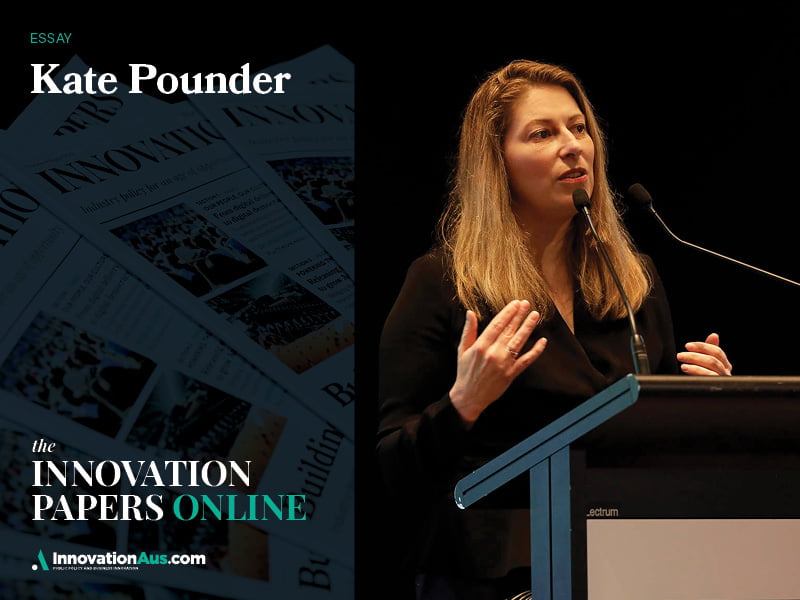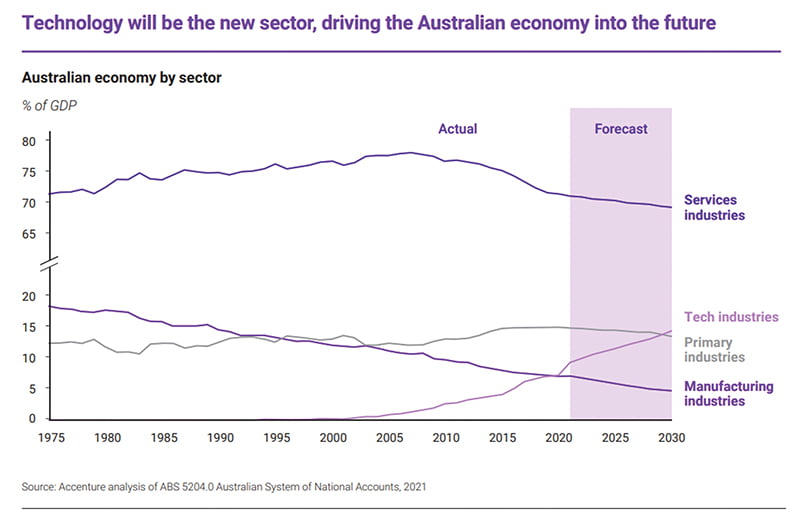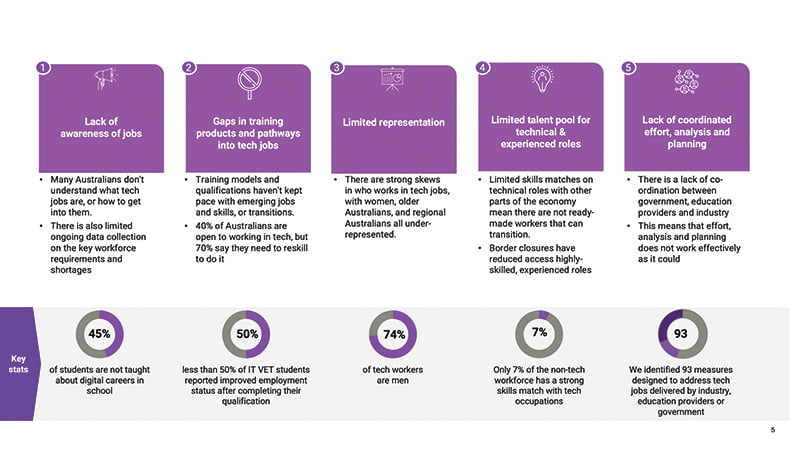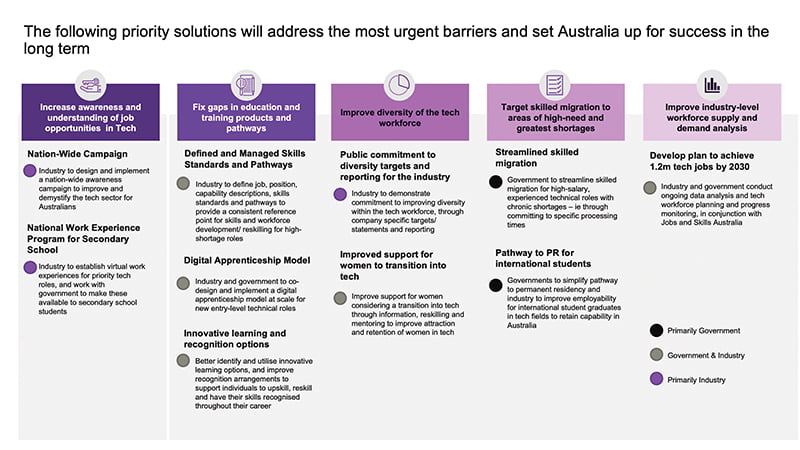The Australian government and the Australian tech sector have a shared commitment to achieve 1.2 million tech jobs in Australia by 2030.
This goal is critical for Australia to realise its potential as a technology powerhouse able to compete and lead on the world stage and support Australia’s broader digital transformation.
Achieving this will drive improved living standards, build our economic future and ensure jobs not just for this generation, but for generations to come.
Setting this goal on behalf of government and industry matters because it sends a clear signal to Australians that employers will sign-up to create these jobs, and there is a shared commitment to help Australians work in them, including through reskilling and training opportunities.
Tech jobs are well-paid, interesting and plentiful. Promotion is fast and opportunities are extensive.

Meeting the demand for skilled workers will be challenging – we forecast that Australia will need to create over 650,000 new tech jobs by the end of the decade, representing an additional 186,000 tech workers above business-as-usual projections to meet this goal.
The good news is, we believe tech jobs represent an opportunity for all Australians. The sector is looking for workers from all backgrounds to join us.
There are both barriers and opportunities to reach our shared goal. But with the right focus, investment and regulation, we will be well-placed to deliver 1.2 million jobs by 2030. What is the tech jobs opportunity?
Tech sector jobs are an important new source of opportunity for Australians.

The tech sector has experienced strong growth in the last decade and is now the seventh biggest employing sector in Australia.
Tech sector jobs grew by 66 per cent from 2005, almost double the average growth rate for all jobs in the Australian economy. In 2020, during the first year of the COVID-19 pandemic, 65,000 tech jobs were created.
One in 16 working Australians work in tech sector jobs, and there are more software engineers and developers in Australia than solicitors, plumbers and, hairdressers
This surge in tech jobs means there are now 861,000 people employed in them across Australia today. That makes the tech sector equivalent to Australia’s seventh biggest employing sector.
Tech sector jobs are spread throughout the economy. The tech sector covers jobs in companies in the direct tech sector (for example, software companies), jobs in online commerce in retail and wholesale trade.
It also covers tech-related jobs in sectors across the economy, such as banking, mining, the public sector and professional services.
Our research shows that tech jobs are some of the most flexible; in particular, employees in tech companies are 1.5 to 2 times more likely to work remotely than tech employees working in non-tech specific companies.
Our research also shows that tech jobs are generally more secure than other jobs. The rate of people no longer working after eight years was 4.7 percentage points lower in tech than high paying industries, and 6.2 percentage points lower than other industries.
There is a lingering misconception that a university degree is mandatory to foster a career in the tech sector. The reality is that there are outstanding opportunities for those who are not university graduates – right now, 42 per cent of workers in the tech industry do not have a university qualification.
Added to this is the fact that remuneration opportunities for people without a university degree are also better in the tech sector relative to comparable industries. Entrants with a VET level education face a pay gap of only around three per cent relative to university graduates, compared to a 17 per cent gap for VET graduates in comparable paying industries.
There is also a tremendous opportunity for women in the technology industry. While we are committed to attracting more female representation, women looking to forge a career in the tech sector face a much smaller gender pay gap than other industries.
The research found that women entrants in the tech sector have a gender pay gap of around 9 per cent compared to women entering comparable industries who face a pay gap of around 18 per cent. Ensuring we’re able to support more women into tech jobs will mean the tech sector is a key driver of women’s economic participation, security and prosperity.
Tech jobs are also spread across the country. As one of the highest-employing sectors in the country, it makes sense that tech jobs are spread across every state and territory in the country.
Tech workers are most likely to live in the middle and outer suburban rings of Australian cities, such as western and southern Sydney, west Melbourne and the southeast of Melbourne.
Cities like Brisbane and Adelaide are now emerging as the new centres for tech jobs growth in Australia. The southeast of Queensland is the fastest growing area for tech jobs in Australia, with five of the top 10 regions for tech jobs growth.
Tech jobs are accessible to people from all walks of life, and with a variety of skills, and there is little discrimination in pay based on education or socioeconomic status once people break into the sector.
There are however significant shortages, particularly for technical and experienced roles.
While Australia has a tremendous tech jobs opportunity, there are barriers we face to meet this opportunity, and industry and government can act to reduce these barriers.
Vacancy rates in tech are 60 per cent higher than the Australian average and are forecast to grow at triple the rate of the broader economy. The most severe shortages are in technical occupations like software programmers and computer network professionals but there are also big gaps in commercial and creative roles like UX designers, IT business analysts and product managers.
Job advertising data shows that both technical and non-technical occupations require more experience and higher levels of qualifications, compared to the national average.
What are the barriers that prevent Australians from seizing our jobs opportunity?
We have identified five key barriers that prevent Australians from seizing our jobs opportunity:
- Australians lack awareness about what tech jobs exist or how to get into them
- Current training products and pathways into tech jobs are not fit for purpose
- There are strong demographic skews in tech jobs, with women, older Australians, and regional Australians being under-represented
- There is a lack of coordination between measures designed to help people get into tech jobs
- There is a small domestic talent pool of people with the skills needed to work in tech
Government and industry need to work together to break down these barriers. We need cross sector initiatives including awareness campaigns to build excitement about tech opportunities, simplifying the experience to identify pathways into tech and coordination through governance and reporting.
We also need occupation-specific initiatives that cover migration and re-engagement of talent for technical roles, attracting students in technical and trade-based education, and building pathways for retraining into commercial and creative roles.
To address the tech workforce shortfall, we need to overcome five challenges

The following priority solutions will address the most urgent barriers
and set Australia up for success in the long term:
- Increase awareness and understanding of job opportunities in tech
- Fix gaps in education and training products and pathways
- Improve diversity of the tech workforce
- Target skilled migration to areas of high need and greatest shortages
- Improve industry-level workforce supply and demand analysis

The Australian technology sector is a critical pillar of the Australian economy, and an important accelerator of jobs and growth. The sector’s economic contribution is not confined to the direct impact of tech businesses as a standalone industry.
Instead, digital technologies are an essential part of the value chain and operations of most businesses in the economy. Technology is enabling growth in sectors as diverse as mining, banking and manufacturing.
The jobs opportunity we have outlined represents a long-term trend that has seen the tech sector produce the most new, high-value Australian companies of any part of the economy in the last three decades, and industries across the economy digitise. These factors are driving a tech jobs goldrush that will long outlast the current economic circumstances.
As we improve our economy in the years ahead, technology has the potential to expand and create great jobs for our kids and grandkids.
All we need to build Australia into the next global tech titan is for people looking to forge a new and exciting career to aspire to the amazing opportunities the technology sector has to offer.
We need to be open to changing the way things have always been done. We need to bring new people into our industry, train them, attract, and retain them with meaningful work.
We must help Australians find pathways into tech jobs.
Kate Pounder is the CEO of the Tech Council of Australia, the peak industry body for Australia’s tech sector. Providing a trusted voice for Australia’s technology industry, with over 140 members, the Tech Council comprises the full spectrum of tech companies.
Do you know more? Contact James Riley via Email.


Kate didn’t study economics or a financial discipline. She cannot assert that tech jobs “drive improved living standards, build our economic future and ensure jobs not just for this generation, but for generations to come.” Nobody can – no economist will – and it’s crazy to echo these baseless claims. Australia is an importer of technologies. Australian demand creates tech jobs in other economies. The Australia government has two interlinked policies – buy, don’t build (buy from foreigners, so it’s not tech jobs in Australia) and cloud first (all the major cloud providers are foreign companies). The combined effect of these policies is the export of taxpayers’ money overseas. The simultaneous effect is to create a Balance of Payments (BOP) imbalance. Australia imports advanced technologies and exports rocks. Writing content for a web site hosted outside Australia and entering product data on an eCommerce site hosted outside Australia are not “tech jobs”. Using a computer for word processing is not a “tech job” any more than driving a car is working in the motor industry. “All we need to build Australia into the next global tech titan is for people” – to want a new job with more pay? With respect Kate, that’s digital koolaid.